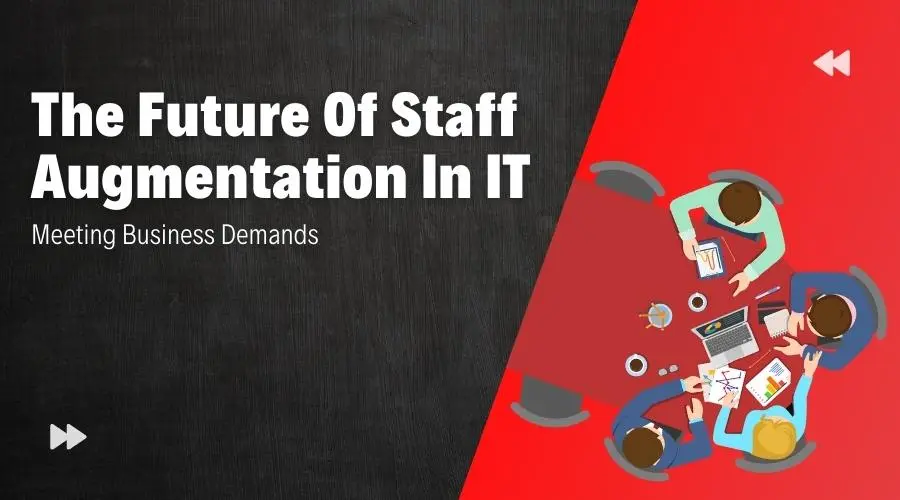In the ever-evolving landscape of technology, businesses are constantly seeking efficient and cost-effective solutions to meet their IT needs. Staff augmentation has emerged as a viable option, providing organizations with the flexibility to scale their workforce and access specialized talent. This article explores the future of staff augmentation in the IT industry and its implications for businesses.
Table of Contents
The Concept of Staff Augmentation
Staff augmentation refers to the practice of supplementing an organization’s workforce with external resources, such as freelancers, contractors, or temporary professionals. In the IT industry, staff augmentation involves hiring skilled IT professionals on a project basis to address specific technical requirements.
Advantages of Staff Augmentation in IT
Staff augmentation offers numerous benefits for businesses in the IT sector:
Flexibility and Scalability
With staff augmentation, organizations can quickly scale their teams up or down based on project demands. This flexibility allows businesses to adapt to changing market conditions and manage their resources effectively.
Access to Specialized Skills
Staff augmentation enables businesses to tap into a diverse pool of specialized IT professionals. Organizations can leverage the expertise of these professionals without committing to long-term employment contracts or extensive recruitment processes.
Cost-Effectiveness
Compared to hiring full-time employees, staff augmentation can be a cost-effective solution. Businesses can reduce overhead costs associated with benefits, training, and infrastructure, as staff augmentation professionals are typically responsible for their own expenses.
Increased Efficiency and Productivity
By integrating skilled professionals into their teams, organizations can enhance their overall efficiency and productivity. Staff augmentation allows businesses to leverage external expertise while maintaining their existing core workforce.
Also Read: Captivate Your Audience: The Power of User-Friendly Websites
Relationship between Manpower and Staff Augmentation
The relationship between manpower and staff augmentation in the context of IT is crucial for businesses seeking to optimize their workforce. Manpower refers to the existing employees or resources within an organization, while staff augmentation involves supplementing the existing manpower with external professionals.
Staff augmentation complements manpower by providing additional skills, expertise, and flexibility. It allows organizations to bridge skill gaps, meet project-specific requirements, and access specialized talent that may not be available in-house. By integrating staff augmentation into their manpower strategy, businesses can enhance their overall capabilities and improve project outcomes.
Furthermore, staff augmentation can alleviate the burden on existing manpower during peak workloads or resource-intensive projects. Instead of overburdening the internal workforce, organizations can engage staff augmentation professionals to share the workload and maintain productivity levels.
The relationship between manpower and staff augmentation should be based on effective communication, collaboration, and integration. It is essential to ensure seamless coordination between internal employees and staff augmentation professionals. By fostering a cohesive work environment and promoting knowledge sharing, organizations can maximize the benefits of staff augmentation while leveraging the existing manpower effectively.
In summary, the relationship between manpower and staff augmentation is symbiotic. By strategically combining the strengths of internal resources and external professionals, businesses can achieve greater efficiency, scalability, and productivity in their IT projects.
Growing Demand for IT Staff Augmentation
In recent years, the demand for IT staff augmentation has been steadily increasing. Several factors contribute to this growth:
Rapid Technological Advancements
As technology evolves at an unprecedented pace, organizations require specialized IT skills to navigate complex systems, develop innovative solutions, and maintain a competitive edge. Staff augmentation provides access to a diverse talent pool capable of meeting these evolving technological needs.
Project-Based Work
Many IT projects have a specific timeline and deliverables. Staff augmentation offers a flexible solution for businesses to bring in professionals with the necessary skills for the duration of the project, reducing the need for long-term commitments.
Global Talent Pool
Staff augmentation allows organizations to tap into a global talent pool, overcoming geographical limitations. With remote work becoming more prevalent, businesses can collaborate with IT professionals from different locations, accessing a broader range of expertise.
Also Read: How Manpower Outsourcing can save time and money for your business?
Emerging Trends in Staff Augmentation
The future of staff augmentation in IT is marked by several emerging trends:
Gig Economy Integration
The rise of the gig economy has had a significant impact on staff augmentation. Many IT professionals are now opting for freelance or contract work, seeking more flexibility and diverse projects. Organizations can leverage this trend by tapping into the gig economy to access highly skilled professionals.
Hybrid Work Models
Hybrid work models, combining on-site and remote work, are becoming increasingly popular. Staff augmentation facilitates this model, allowing organizations to seamlessly integrate external talent into their teams, regardless of their location.
Artificial Intelligence and Automation
Artificial intelligence (AI) and automation are transforming the IT industry. While some fear that these technologies may replace human workers, staff augmentation can adapt to these changes. IT professionals with expertise in AI and automation can support businesses in implementing and optimizing these technologies.
The Impact of Artificial Intelligence and Automation
Artificial intelligence and automation have the potential to revolutionize staff augmentation in IT. These technologies can streamline processes, enhance efficiency, and improve decision-making. Businesses can leverage AI and automation tools to match the right professionals with specific projects, reducing time and effort in the recruitment process.
Addressing Challenges in Staff Augmentation
Despite its benefits, staff augmentation also presents challenges that need to be addressed:
Cultural Integration
External professionals brought in through staff augmentation may face challenges integrating into the existing organizational culture. Businesses should foster an inclusive environment that promotes collaboration and ensures effective communication between internal and external team members.
Knowledge Transfer
When working with staff augmentation professionals, knowledge transfer becomes crucial. Businesses should establish processes and documentation to facilitate the transfer of knowledge between internal and external resources, ensuring seamless project continuity.
Future Collaboration Models
The future of staff augmentation lies in collaborative partnerships between organizations and external professionals. Instead of traditional client-vendor relationships, businesses are adopting more collaborative models where staff augmentation professionals become an integral part of the team. This shift fosters better communication, knowledge sharing, and synergy among team members.
Security and Confidentiality Concerns
As businesses engage external professionals, security and confidentiality become critical considerations. Organizations must establish robust data protection measures, enforce non-disclosure agreements, and ensure compliance with relevant regulations to safeguard sensitive information.
Industry-Specific Staff Augmentation Solutions
Different industries have unique IT requirements. Staff augmentation providers are increasingly tailoring their solutions to meet these specific needs. Whether it’s healthcare, finance, or manufacturing, businesses can find staff augmentation professionals with industry-specific knowledge and expertise.
Integrating Remote Work and Staff Augmentation
The COVID-19 pandemic has accelerated the adoption of remote work. Staff augmentation aligns well with this trend, allowing businesses to seamlessly integrate remote professionals into their teams. By leveraging digital collaboration tools, organizations can ensure effective communication and collaboration, regardless of the location of their staff augmentation professionals.
Training and Skill Development Initiatives
To ensure the success of staff augmentation, organizations should invest in training and skill development initiatives. By providing opportunities for professional growth and upskilling, businesses can enhance the capabilities of their staff augmentation professionals, leading to higher-quality project outcomes.
Sustainable Staff Augmentation Practices
Sustainability is becoming an essential consideration for businesses. In staff augmentation, sustainability involves promoting fair working conditions, diversity, and equal opportunities for all professionals involved. Organizations should prioritize ethical and responsible staff augmentation practices to build long-term partnerships and maintain a positive reputation.
Compliance and Legal Considerations
As with any employment arrangement, staff augmentation requires compliance with labor laws and regulations. Businesses engaging in staff augmentation must ensure adherence to local employment laws, tax regulations, and intellectual property rights to avoid legal complications.
Also Read: Crucial Reasons Why Manpower Outsourcing Can Be Beneficial
Ethical Implications of Staff Augmentation
Staff augmentation raises ethical considerations, such as fair compensation, equal treatment, and avoiding exploitation of professionals. Organizations should uphold ethical standards by providing competitive compensation, fostering a supportive work environment, and respecting the rights and dignity of staff augmentation professionals.
Conclusion
Staff augmentation in the IT industry offers businesses the flexibility, specialized skills, and cost-effectiveness they need to thrive in the ever-changing technological landscape. As emerging trends, such as the gig economy, hybrid work models, and AI automation, shape the future, organizations must adapt to maximize the benefits of staff augmentation while addressing the associated challenges. By embracing collaboration, investing in skill development, and promoting ethical practices, businesses can leverage staff augmentation to achieve their strategic IT goals.


